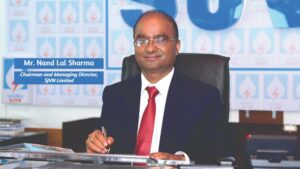By Krishna Kumar Mishra
Malay Mukherjee, Managing Director & CEO, IFCI in conversation with Krishna Kumar Mishra
Malay Mukherjee was appointed as MD and CEO of IFCI in December 2013. Prior to this, he was the ED of Central Bank of India, where he was looking after several important portfolios. Mukherjee has more than 40 years of experience in banking and since he took over there has been a lot of happenings at financial front, most of which got unnoticed. The ride continued unabated till two quarters back when the company, like other banking institutions in the country, had to take certain unheard of decisions.
After he joined the company, the icing on the cake was its June 2015 quarter results when the company reported a 7.5 per cent rise in its net profit on higher interest income. Net Interest Income (NII) for the quarter was much higher at Rs 233 crore against Rs 104 crore in the corresponding quarter in the previous year due to growth in loan book and no fresh NPAs in the current quarter. Total income during the quarter increased by 24 per cent over the same period a year ago. Gross NPA was reduced to 9.7 per cent from 10.3 per cent a year ago. Net NPAs also cut to 6.8 per cent from 7.2 per cent, while the NIM increased to 3.3 per cent from 2.1 per cent in the corresponding quarter of previous fiscal.
Mukherjee is all set to repeat that performance in this very financial year. He answered some of the hard hitting questions with ease and with full transparency that shows his seriousness.
When are you going to take a call on whether to apply for banking licence with the RBI?
Actually, the detail proposal for this is going to the board. It is likely to happen in the month of September itself. As of now the management has decided that we should go to the board first and then approach the government for the clearance and apply for it.
If you see the investor’s point of view, IFCI is in fact passing through an identity crisis. Successive management has given only false hopes. It holds neither a DFI status, nor a bank or MFI.
I can’t comment on the perception of an investor, even if that is totally false. But they have to understand that IFCI’s earlier role was DFI, primarily to fund the long term infrastructure growth. We still feel there is a scope for long term infrastructure growth and there IFCI can play a very dominant role and sooner than later occupy that space. But as NBFC, it is not able to do so. Obviously the cost of fund is high and by raising bond the cost will become still higher. We are of the firm opinion that our balance sheet needs a little bit of restructuring and after that again we should try, not the earlier, a different model to finance the core as well as the noncore infrastructure in days to come. We find enough demand for long term players. And please remember there is no other player who is able to do that.
And to the second part of your question I am very clear that we have never given any false hope. It takes time for a structure to undergo a change. If you look at the past history, from DFI to NBFC it has taken a long journey and subsequently after it became NBFC it became a government controlled NBFC and that again took some more time. So now probably the most decisive phase is on the way. As far as we are concerned the goal is very much decided that we should be in the market as a long term infrastructure and non-infrastructure player.
So how you define IFCI?
As I explained, even if we are NBFC which we are, we are a non-deposit taking NBFC and that is the reason our cost of fund is higher. We are conceiving an internal approach to improve the credit rating of IFCI. For that purpose, it is necessary that impaired assets of IFCI have to be kept in a separate vehicle and the running assets should remain in the IFCI book. We believe that way IFCI rating will zoom. The moment the rating is high the scenario will automatically change. We are already A Plus, when we become AA and AAA and, not to forget our government holding of more than 50 percent, then the investors will be in a position to take a call. Foreign investment will also come in and they will have a long term vision for this company. So I’ll only say that it is a transition phase. Maybe within six months to one year the picture will be very clear. Being a listed company I would not like to disclose anything more than that, but I repeat within six months picture will be much clearer and we believe we are on the right path.
Is there any likelihood of government holding going up? Are do you feel the company is fully capitalised?
As I said there is no necessity because presently the holding that they have is sufficient enough and we don’t need any capital infusion. As of now the company is fully capitalised. Our capital adequacy ratio is more than 16.5 percent, whereas the Reserve Bank of India’s norm is 15 percent. But if there is any requirement, we can always go and tap the market. There are various ways it can be done as enough headway is available. We can raise tier 1, tier 2 and there shouldn’t be any problem.
What is your present asset size? Are you happy with your asset quality?
The size is around 37,000 crore. Well, like any other financial organization, we have also passed through a difficult phase in the last two quarters. If you see the last three years, the earlier two and half years we were quite satisfied that in spite of difficulty faced by the banks we as NBFC were able to do well. But the last two quarters have not been good. I see this pain will continue for one more quarter. After that things will start improving.
Earlier you were anxious to get DFI (Development Financial Institution) Status to reduce the cost of borrowing?
We tried our best to plead the case with RBI, the regulator, but in their considered opinion this is not required in the country. That’s the view of the RBI and probably they are the best judge. They understand the matter better than any other organization. We have completely dropped the idea of trying to convert ourselves as a DFI. That chapter is fully closed. As I told you there are also other ways to reduce the cost which we are now exploring.
Do you think the government should revive DFIs as a vehicle to meet infrastructure financing needs?
In our opinion, yes. But as I have told you the regulator is the final authority who has to take a call of having a DFI in the country or not. Probably that is a closed issue as far as the regulator is concerned.
IFCI has several strategic investments – all in healthy condition. Like NSE, SHCIL, ACRE etc. So how you define your core and non-core assets?
Obviously, what is not related to the business, we call as noncore assets. So all those investments can always be called as noncore assets. Noncore is one which does not yield you any result. Like we had in real estate when our employee strength was very high. We had so many offices. Similarly, there are some consultancy organizations throughout the country where IFCI, IDBI and ICICI had stakes. Some of them have already exited. So those are noncore assets because that is not the business we are looking at. We are trying to exit from those assets. Unless they are listed, getting a proper valuation and exiting is a difficult call. We would certainly not like to do a loss transaction. I don’t think we have more than 2500 crore of noncore assets and minus this amount, you can say others are all core assets.
What about your planned divestment in SHCIL, NSE, then in TFCI?
We have done partial divestment in NSE but then we have stopped now because we understand NSE is getting listed in the month of January or February 2017. Secondly, there is great demand for the NSE stocks so at this point in time doing a one to one deal may not be a wise decision. So we have decided to wait till it gets listed.
Whereas SHCIL is concerned, its valuation will also go up as it has some stake in NSE. This is the reason we will have to wait till NSE is listed for divesting our stakes partly in SHCIL and NSE fully. But SHCIL is in a different process. Unless it gets listed, you can’t exit and the process has also to run. One has to find a merchant banker and the valuer. Being a government company there is a clearance required from Niti Aayog. All that will take time and that may not happen in this financial year. Whereas NSE is on card in this financial year if it gets listed.
TFCI is one of our associate concerns and we find value for money there. We have reduced our stake partly and it has given a very good return to us. We have decided to hold it for some more time. We are exiting totally from ACRE because that is not the business we are in. ACRE had also not been paying us any dividend for all these years. One more strategic sale has happened where we completely exited. We could not sell KITCO stake because we could not find a proper buyer. So that still hangs.
And what kind of funds are you looking at from these transactions? Any target as such.
Funds depend entirely on valuation. Also, that is not a part of our regular budgeting because those things come as an extraordinary cash flow for that particular year. So when we do budgeting, we budget for the business model. How much we lend, how much we invest and how much money comes out of that and how much money comes out of recovery and profitability is worked on that. Over and above, this comes just like a bonus for us. Basically, it is happening because of a particular event at that particular time. If it comes it will add to our top line and bottom line. But we can’t fix a target on such matters.
How do you plan to use these funds?
Whatever money we have borrowed partly it will be used for paying back. We don’t want to expand or invest in something else. As per routine our lending and investing will keep on happening. But when the money comes first thing we would like that, our borrowing comes down. There is absolutely no question of acquiring any asset using that money.
When you took over your main concern was NPAs. How far the cleanup process has been successful?
Yes, it still is. I was successful to reduce the NPAs to a great extent and brought it down to 9 percent. But now again it has gone up to 19 percent and it all happened in last two quarters. But I also must mention here for the benefit of your readers that if you look at the percentage it does not give a correct picture – you have to see that in absolute terms. Our book size is small, so if a small NPA rise is there in the percentage wise it looks bloated, but quantum wise it is not that big.
NPAs are going up because of two reasons. One is that some of the companies who are over leveraged are finding it difficult in present circumstances to cope up. Also the economic scenario which was there at least one and half years back has also put them down. Now, with the various steps taken by the government, there is some road visible and there is definitely a case for them to go ahead. And once that speed up the cleanup process what has started on the banks is going to help even NBFCs like us.
Your bottom line performance was weighed down by higher provisioning. Can you elaborate the reasons?
There is one infrastructure company where around 190 crore we have given. We found that our security which was valued for around Rs 400 crore, in subsequent valuation we have found it is much lesser than that. Since recovery process may be difficult in this case so we have made a 100 percent provision in this case. However, we are taking hard recovery measure against the borrower. So this is a temporary phenomenon. Another was a diversified infrastructure company in Delhi that has become NPA in most of the banks two quarters before it happened with us. We thought it will remain, but it did not happen. And third was a major auto component company which also became NPA in other banks earlier. This quarter also there may be a problem with one or two accounts. As I told you one more quarter is a challenge for us.
But how one or another keep popping up?
You must understand that NPAs happens as per the norms of RBI. If the interest and installment are not paid within the stipulated time, like in banks 90 days and for us it is 120 days, then this becomes NPA. So you cannot clean up before it becomes overdue. If they are not paying on time (120 days) then only it becomes a case of NPA. To say nothing will happen in the future is impossible. But we have to be careful in choosing the assets which we are financing.
What trend you see in revenue and profit growth rate and bad loan recovery in this financial year?
Recoveries have started coming in from the bad assets, but the process is slow. And I repeat that till September quarter results, we have a challenge. December quarter onwards the result is likely to be better. But I can’t quantify right now. A miracle cannot happen in the financial sector, it has never happened.
But your last year June quarter was indeed a miracle?
But we were not expecting that. That was also not a miracle, it was the outcome of persistence.
IFCI has a very rich legacy yet the newcomers in case of banks like Yes or Kotak, or many MFIs have in a very short span of time taken a lead. They have overshadowed IFCI.
They are banks but we are NBFC. These are two different entities. So there shouldn’t be any comparison. The best part with them was that they had not carried any legacy at all and started with a clean slate. If you look at the market cap of new banks like HDFC or Kotak Mahindra Bank, they have a market cap of much more than many of the top public sector banks. But what they do and what public sector banks do are two different things. So it will not be proper to compare a newly started private sector bank with a 1948 established DFI. To answer the second part, please remember NBFCs and banks cannot be compared. What banks cannot do only NBFC does. NBFCs have a different and a specific role to play, which banks cannot do. So NBFCs existence has to be there.
What is the way forward?
I’ve already told you that once our rating goes up we can get money raised through bonds in India and also globally at a very competitive rate. And in that case since bonds can be raised for a long time period, we can again become a long term player and fund our core and noncore infrastructure.
So unlike many other public sector companies you are not satisfied being a minion?
No, absolutely not. We were here to play a specific role and even today we are into nation building in a big way.
What is that which is holding back the institution? One section of investors believes that it is the legacy of mindset rather than business?
I don’t think that’s a correct way to define it. Legacy, yes, we have the legacy issue, but mindset is different. Now for the top management, we have come from banks so obviously we are not carrying any baggage. So it is not that the internal people are carrying the legacy and they are at the top. No. In fact the business model that we have is not competitive enough and we are working on it.
Investors also feel IFCI is no one’s baby. How you can instill confidence in them?
Why they think so, I can’t understand. The only reason I find is that we are not a retail player so we don’t come out often to interact with media. We are a wholesale player. But we do interact with media on a quarterly basis when we announce our result. When we had a public issue we had a road show throughout the country. But being not a retail player we don’t want that money should be spent on the publicity unnecessary.
About the confidence part I can assure that NSE sale will give us big money and the profit for that quarter will jump up. But how much, and when will be a futuristic statement. We see a great future in IFCI and people who have invested in IFCI should have faith in the management and the board. About the past two quarters all I can say is that they should compare with all the banks. It cannot happen that all banks are showing bad results and NBFCs will alone show good results. If that is happening, then definitely something is wrong. But investors must remember IFCI has some very interesting and definite trigger points.






















